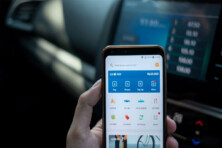Taxify has rebranded to Bolt. What other changes await their customers?

Riding with Bolt: pros & cons. Source: facebook.com
The name change is linked to the expansion of transportation services. Bolt brand is already known in the USA as the firm offering electric scooters for rent. The time has come for Europe to embrace emission-free ride-hailing as well. Taxify has taken up the initiative of its Bird and Lime competitors and enrolled e-scooters in the business too.
E-scooters give the riders more flexible opportunities to travel around the cities. They are cheaper than cars and less toxic to the environment. In addition, according to statistical data, about 20% of all Taxify (Bolt) rides are less than 3 km. This short distance may take too long for a car once it gets into a traffic jam. Scooters, on the other hand, are mobile and may use alternative routes.
Furthermore, having this new transport alternative on board, Bolt now can enter new markets where they were banned before because of regulatory limitations. For instance, the company couldn’t previously operate in Germany or Spain.
Bolt features
The Bolt app is easy to use and works on a familiar scheme: passengers request a ride, track their car movement on the map, pay either in cash or automatically on the app, and rate their ride.
Drivers can register individually or as a business entity (under special conditions for fleet owners). They pay a 20% commission fee from each ride to the company for connecting them with clients.
The program identifies your location with GPS so that the departure point can be filled in automatically.
With the new e-scooter option, the process will be a little bit different. Users may come across a Bolt scooter in the city and decide to take a ride. The app will also show the location of the nearest scooters, as they are GPS-tracked. Clients can unlock them by scanning the QR code on the scooter using the Bolt app. The ride will cost 15 cents a minute, with a minimum fare of €1. The fee should be calculated and paid on the app.
Company employees will collect the scooters in the evenings for recharging.
Users should follow the updates of the old Taxify app in order to get access to its new options. The implementation of the e-scooter service will take place gradually, so keep track of the added locations.
Bolt also offers food delivery in their separate app – Bolt Food. Regular Bolt drivers may register there to become couriers. The owners of bikes and motorcycles are welcome as well.
Pros & Cons
On the bright side,
- The app’s interface is intuitive.
- It’s normally cheaper than Uber.
- It allows for convenient and safe cashless payments. The sum of payment is calculated before the ride.
- The new e-scooter service is eco-friendly and socially responsible.
- It gives cheaper opportunities for daily commuting without using public transport.
- There is a bonus reward for inviting friends to install the app and join the community. Some promo codes are also often offered.
- The company is developing dynamically and quickly entering new markets. It also performs food delivery.
There are also some drawbacks:
- The service is relatively young and still not too widespread. Despite the global presence in 30 countries, it works only in 100 cities, mostly in large urban areas.
- There is no wide selection of car types available as compared to its competitors.
- The destination place should be inserted manually, it is not chosen on a map.
- There is no separate stopover option for rides. It’s inconvenient for a few passengers sharing the ride from the same departure place to different destinations.
- There are no additional riding options in the service such as traveling with children (that require a safety seat) or transporting pets etc. It lacks personalization and flexibility.
- As the app is now going through an update process, the cases of technical errors or failures become more frequent.
SEE ALSO:








